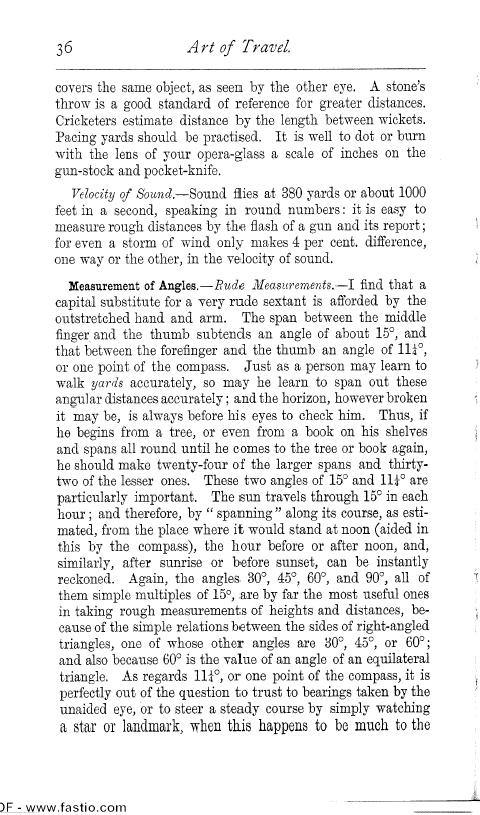| ||||||

OCR Rendition - approximate36 Art of Travel. covers the same object, as seen by the other eye. A stone's throw is a good standard of reference for greater distances. Cricketers estimate distance by the length between wickets. Pacing yards should be practised. It is well to dot or burn with the lens of your opera-glass a scale of inches on the gun-stock and pocket-knife. Velocity of Sound.-Sound flies at 380 yards or about 1000 feet in a second, speaking in round numbers : it is easy to measure rough distances by the flash of a gun and its report ; for even a storm of wind only makes 4 per cent. difference, one way or the other, in the velocity of sound. Measurement of Angles.-Rude Measurements..-I find that a capital substitute for a very rude sextant is afforded by the outstretched hand and arm. The span between the middle finger, and the thumb subtends an angle of about 15°, and that between the forefinger and the thumb an angle of llt°, or one point of the compass. Just as a person may learn to walk yards accurately, so may he learn to span out these angular distances accurately ; and the horizon, however broken it may be, is always before his eyes to check him. Thus, if he begins from a tree, or even from a book on his shelves and spans all round until he comes to the tree or book again, he should make twenty-four of the larger spans and thirtytwo of the lesser ones. These two angles of 15° and 11'4-' are particularly important. The sun travels through 15° in each hour ; and therefore, by " spanning" along its course, as estimated, from the place where it would stand at noon (aided in this by the compass), the hour before or after noon, and, similarly, after sunrise or before sunset, can be instantly reckoned. Again, the angles 30°, 45°, 60°, and 90°, all of them simple multiples of 15°, are by far the most useful ones in taking rough measurements of heights and distances, because of the simple relations between the sides of right-angled triangles, one of whose other angles are 30°, 45°, or 600; and also because 60° is the value of an angle of an equilateral triangle. As regards 11±°, or one point of the compass, it is perfectly out of the question to trust to bearings taken by the unaided eye, or to steer a steady course by simply watching a star or landmark, when this happens to be much to the )F - www.fastio.com |